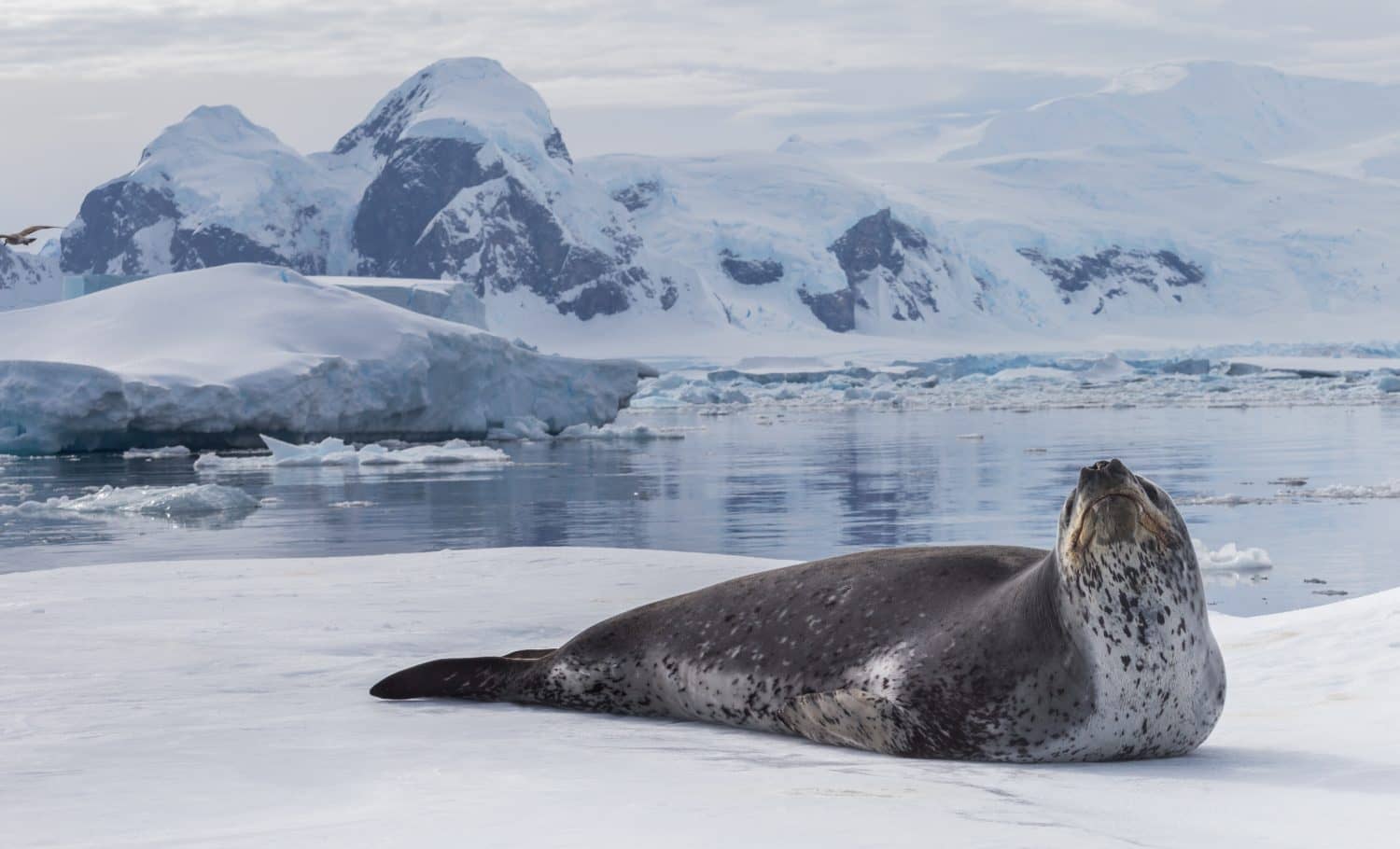The South Pole is one of the most remote places in the world. Evoking a sense of fascination and wonder in the minds of people both young and old, it is a land known for its extremes. The South Pole is a place where icy landscapes stretch for as far as the eye can see. It is a place historically known as the frontier of exploration and science. In this article, we will set out on a journey to uncover everything you ever wanted to know about the South Pole! Let’s begin by exploring its location, climate, and unique native wildlife. We will then explore the various positive and negative impacts of humans on the South Pole, as well as the importance of conserving it.
Where is the South Pole?
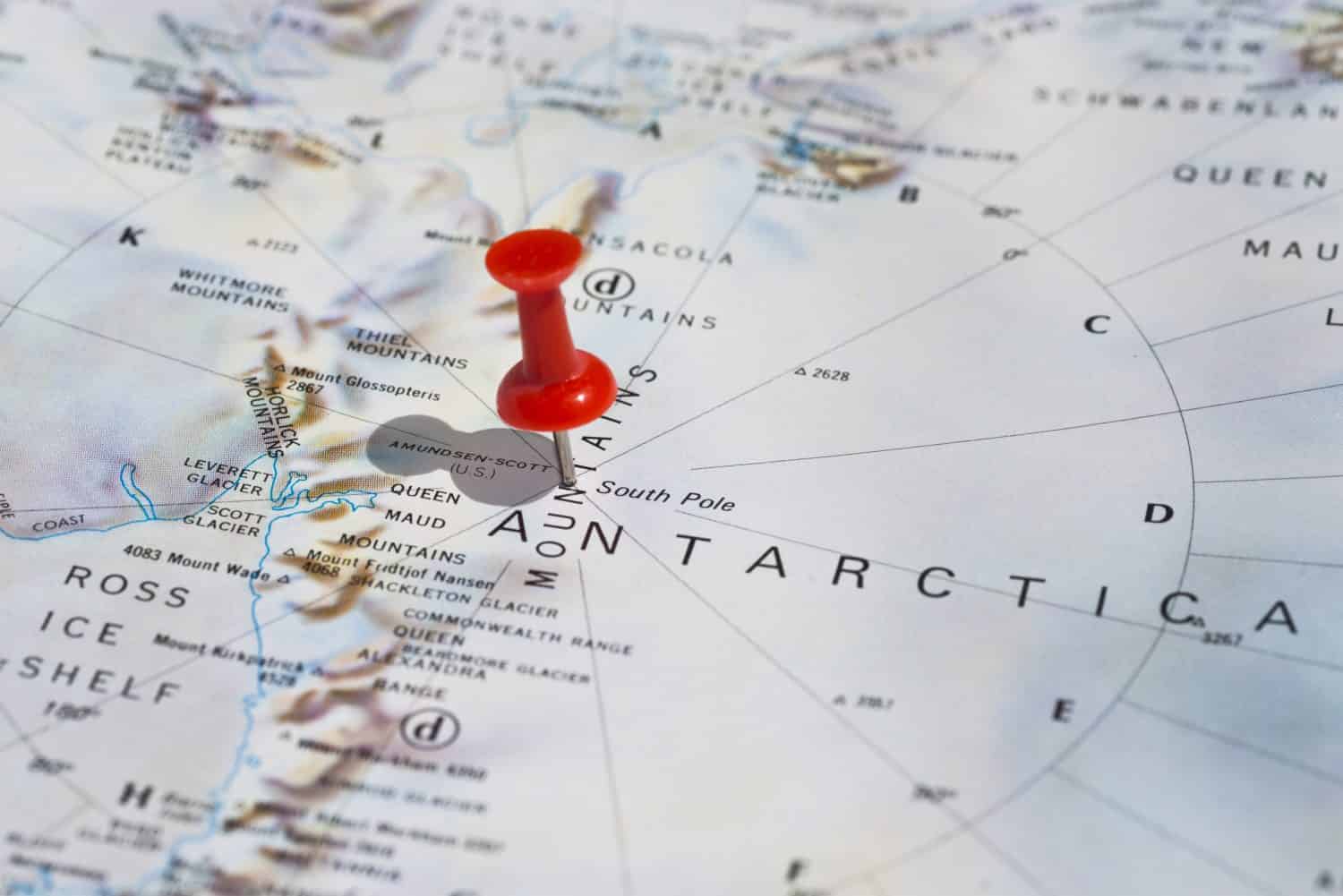
Antarctica gets its name from the Greek word “antarktikos” which means “opposite to the Arctic.” In a more literal translation, the word means “no bears.” Alternatively, the Arctic means “bears.”
©Istimages/Shutterstock.com
Since many people are unaware of the precise location of the South Pole, it is important to understand this information first. To start, the South Pole is located at the very bottom of the globe, making it the very spot on which our planet spins. It is the theoretical point where all lines of longitude meet, which is the exact opposite of the Magnetic North Pole in the Arctic. To put it simply, the South Pole is the southernmost point on Earth.
Nestled at the center of the Antarctic landmass, the South Pole lies about 9,000 feet beneath the glacial ice sheet at 328 feet above sea level. To be clear, Antarctica is not the South Pole, but rather the continent on which the South Pole can be found. To provide a better understanding of the South Pole, this article will offer information about the larger region of Antarctica that encompasses it.
What is the Geography and Climate of Antarctica?
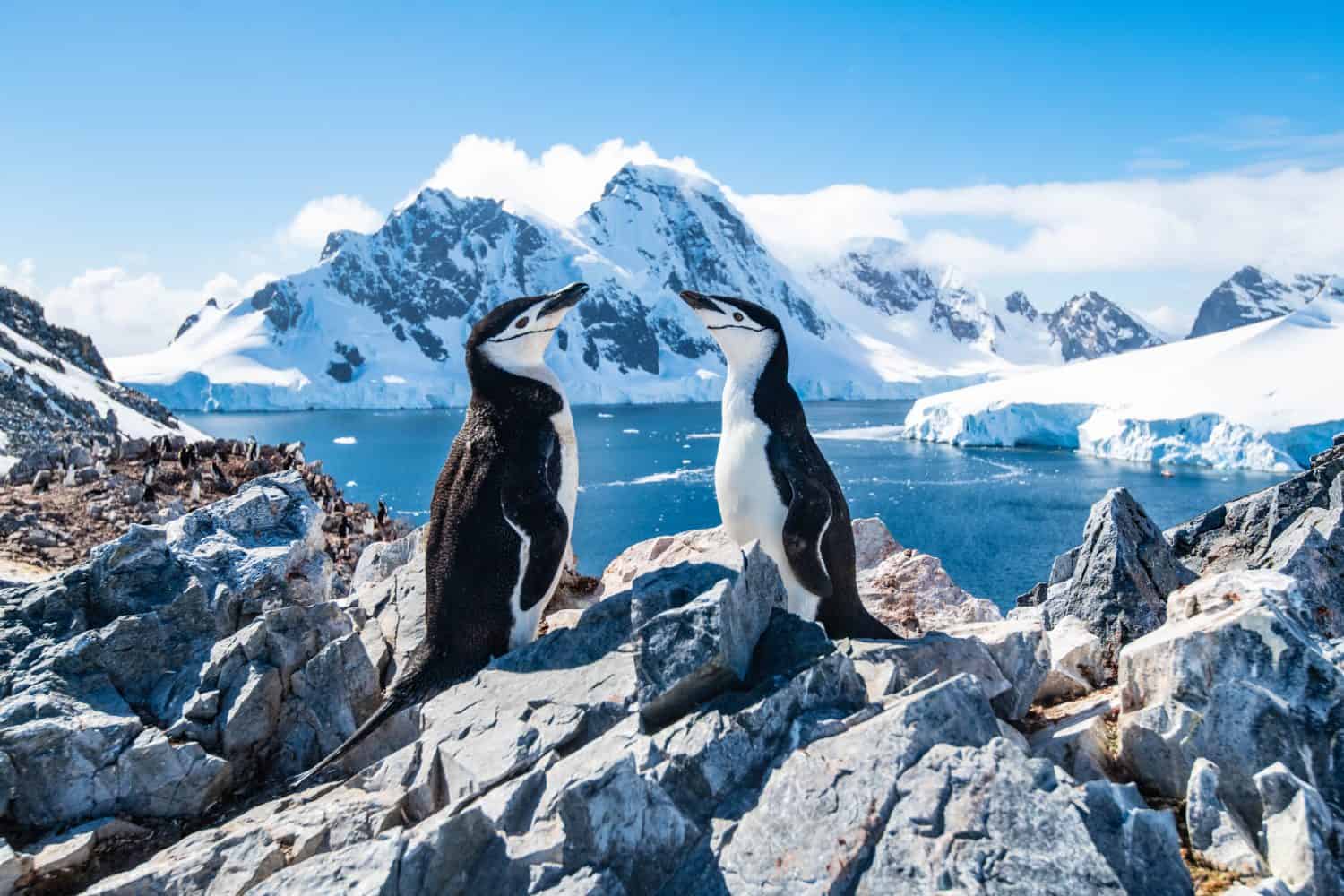
Since it is surrounded by the ocean and receives more fierce winds, the South Pole is remarkably colder than the Arctic.
©SZakharov/Shutterstock.com
The South Pole, surrounded by a vast expanse of frozen terrain, is undoubtedly the coldest, windiest, and driest place on Earth. Because of its remote location, its climate and geography are both quite intense.
Geography
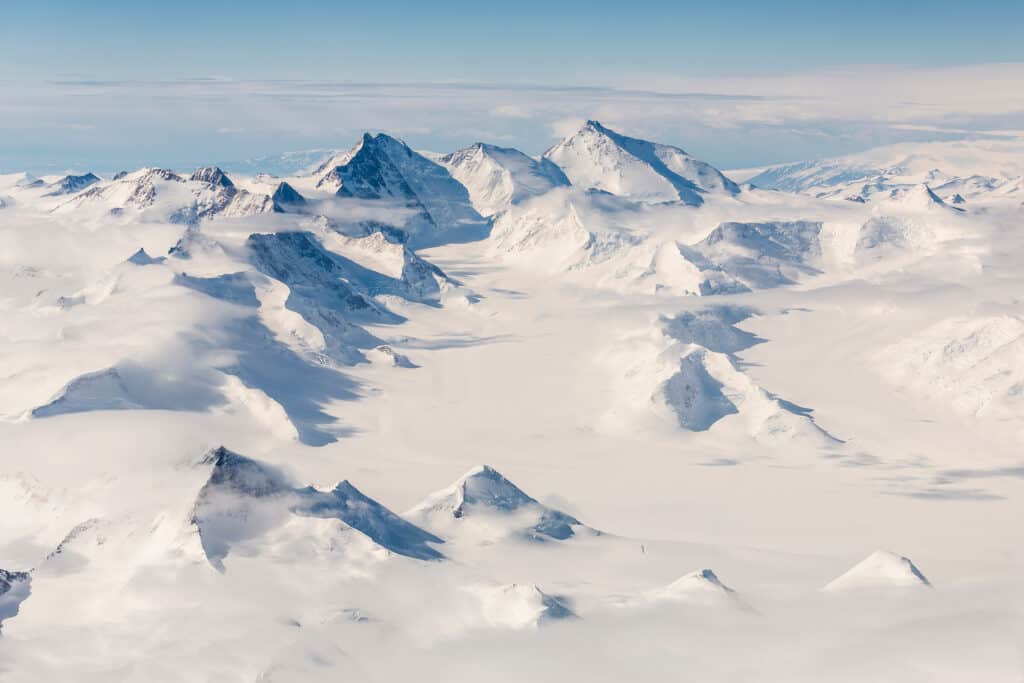
Antarctica’s Trans-Antarctic Mountains, as seen from the air.
©Matt Makes Photos/Shutterstock.com
To begin, the continent is divided into two main regions: Eastern and Western Antarctica. These two areas are separated by the Trans-Antarctic Mountains. Beneath its expansive ice sheet, Antarctica’s 5.4 million square miles contain a hidden landscape of mountains, valleys, and plains. Nevertheless, in these areas, the land is almost completely free of vegetation. The most common plants found in Antarctica are mosses, grasses, shrubs, lichens, and sedges. It also contains a diverse makeup of fossiliferous limestone (limestone with a lot of fossils or trace fossils), metamorphic rocks, glacial deposits, and deep magmatic rocks.
Furthermore, Antarctica is the highest continent on Earth. This is mainly due to its thick ice sheet, which is 7,086 feet thick and runs about 3 miles below the Earth’s surface. It is likely one of the most important ice sheets in the world, since it holds about 90% of the world’s freshwater reserves. If the entire Antarctic Ice Sheet melted, the sea level would rise by about 200 feet! To continue, Antarctica’s highest point is in the Australian Antarctic Territory, which is at a 13,451-foot elevation. More specifically, Mount Vinson is the highest mountain in Antarctica — measuring 16,050 feet at its highest peak.
Antarctica, although known for its freezing temperatures, is home to more than 138 volcanoes! Of these, Mount Erebus and Deception Island are the only two active ones, while the rest are classified as dormant Holocene volcanoes. For background, Holocene volcanoes describe those that have been active in the last 11,700 years — the timeframe that spans our current geographical epoch. Dormant volcanoes are not likely to erupt, whereas active volcanoes can erupt at any time.
Climate
The climate at the South Pole is relentlessly harsh. Extremely low temperatures, often dropping below -94 degrees Fahrenheit, dominate the region. Because of this, Antarctica has an ice-cap climate. This term describes any polar climate with no mean temperature exceeding 32 degrees Fahrenheit. This continent also experiences one of the most extreme day-night cycles in the world!
The summer season in Antarctica starts in October and ends in March. During this time, there are 24 hours of non-stop daylight. On the other hand, Antarctica is hit with near-constant darkness throughout its winter months. This period runs from mid-March to early October. These extremes are even more apparent the closer it gets to the June and December solstices. As a result, it is hard to determine time in the South Pole. While it should theoretically be located in all time zones, since they all converse there, most scientists follow the same time zone as New Zealand — the GMT zone.
It might come as a surprise, but the South Pole is actually classified as a desert! While it doesn’t have the rolling sand dunes and hot weather that most people picture when they think of this type of climate, Antarctica still receives about the same amount of rain each year as the Sahara Desert. Though the South Pole is covered entirely in ice, both of these contrasting desert environments see very little precipitation throughout the year, averaging a mere 10 inches (or less). This makes it exceptionally difficult for plants and animals to survive. Nevertheless, there are quite a few notable animals that have adapted to living in Antarctica’s extreme climate.
What Animals are Found in Antarctica?
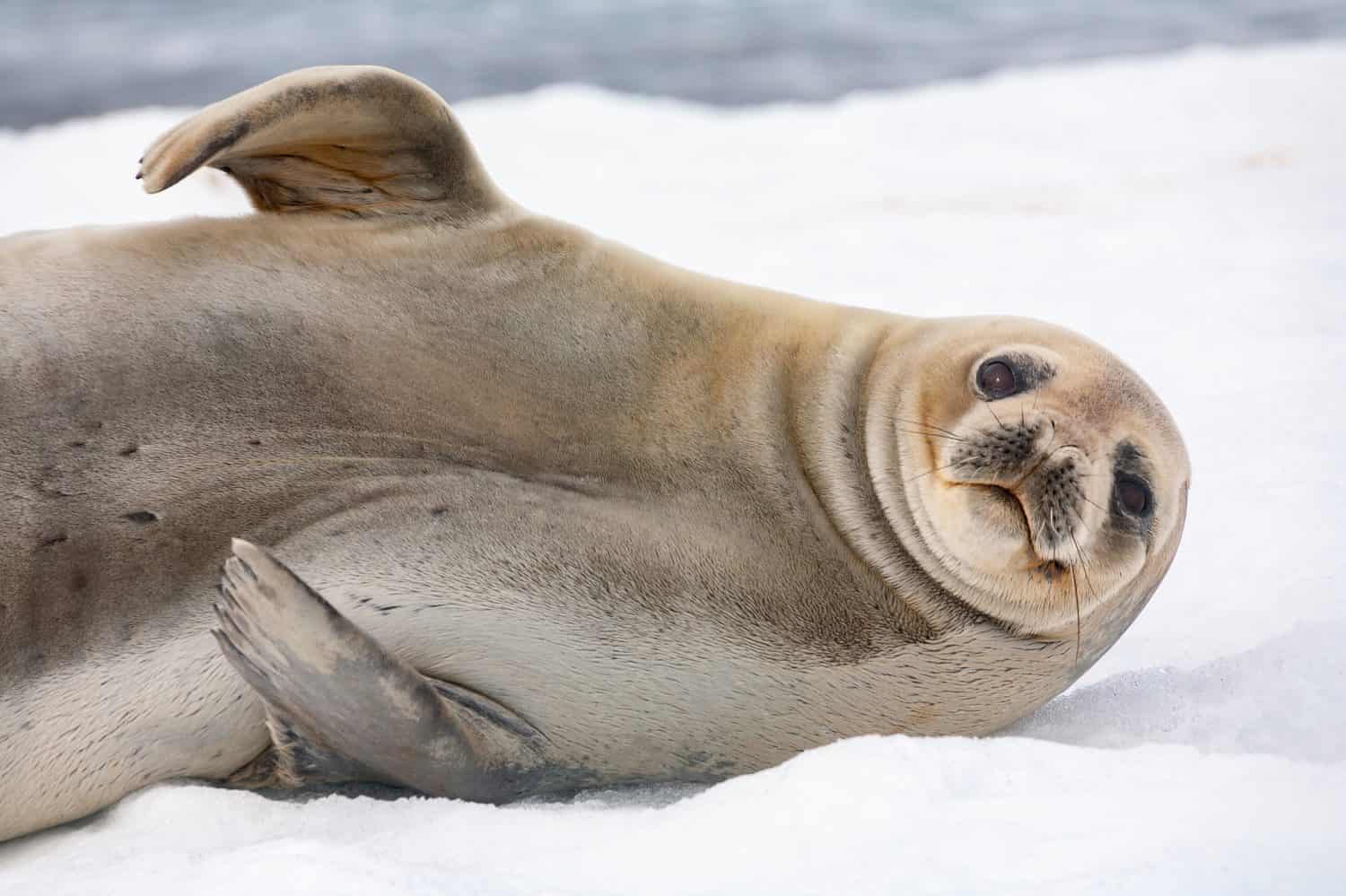
Even though the region has one of the most extreme climates in the world, many animals have adapted to life in Antarctica.
©Steve Allen/Shutterstock.com
Despite the many challenges animals face in Antarctica, it is home to more than 1,142 different land- and water-dwelling species! One of the most famous and prevalent natives are penguins, which have an estimated population of over 5 million. Of the 18 different penguins found throughout the world, only five live on this continent: the Emperor, Adélie, Gentoo, Rockhopper, Macaroni, Magellanic, Chinstrap, and King penguins. Weddell and leopard seals are also found in Antarctica, kept warm by thick layers of fat. Additionally, blue whales love to peruse the waters surrounding the Antarctic. Besides penguins, there are not many other land animals. Common cold-weather mammals like polar bears and arctic foxes can be found at the North Pole, though. If you really want to spot some bears in Antarctica, keep an eye out for tardigrades, but you will have to have a microscope!
Do Humans Live in Antarctica?
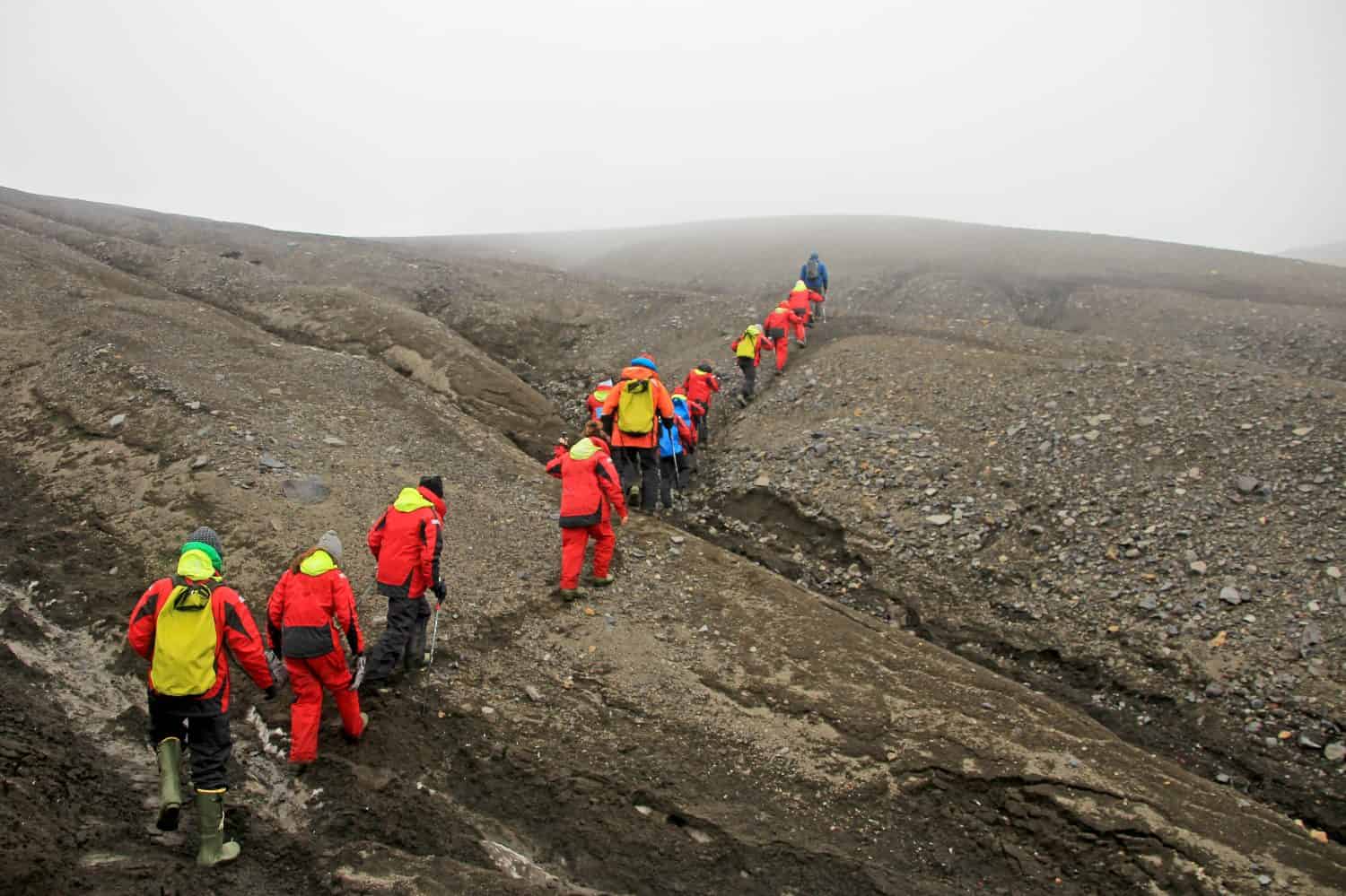
While exploring Antarctica is fun, many experts come to the area for research purposes.
©reisegraf.ch/Shutterstock.com
For much of Earth’s history, no one even knew Antarctica existed! The first discovery was made in 1820 by a Russian expedition team under the command of Captain Fabien (Thaddeus) Gottleib von Bellingshausen. However, at the time, these world-wide explorers thought they were simply looking at an ice field. The first mainland expedition to Antarctica is fiercely debated, with credit split between an Imperial Russian Navy officer, a U.K. Royal Navy officer, and an American sealing captain. Today, there are no people living in Antarctica permanently, though many scientists and tourists visit the area regularly.
The region is governed by the Antarctic Treaty System, which promotes scientific research and the preservation of the land. The region is demilitarized, and nuclear / radioactive activities are prohibited in order to guarantee that Antarctica is only used for peaceful purposes. This important treaty system also encourages environmental stewardship.
What are Scientists Doing in Antarctica?
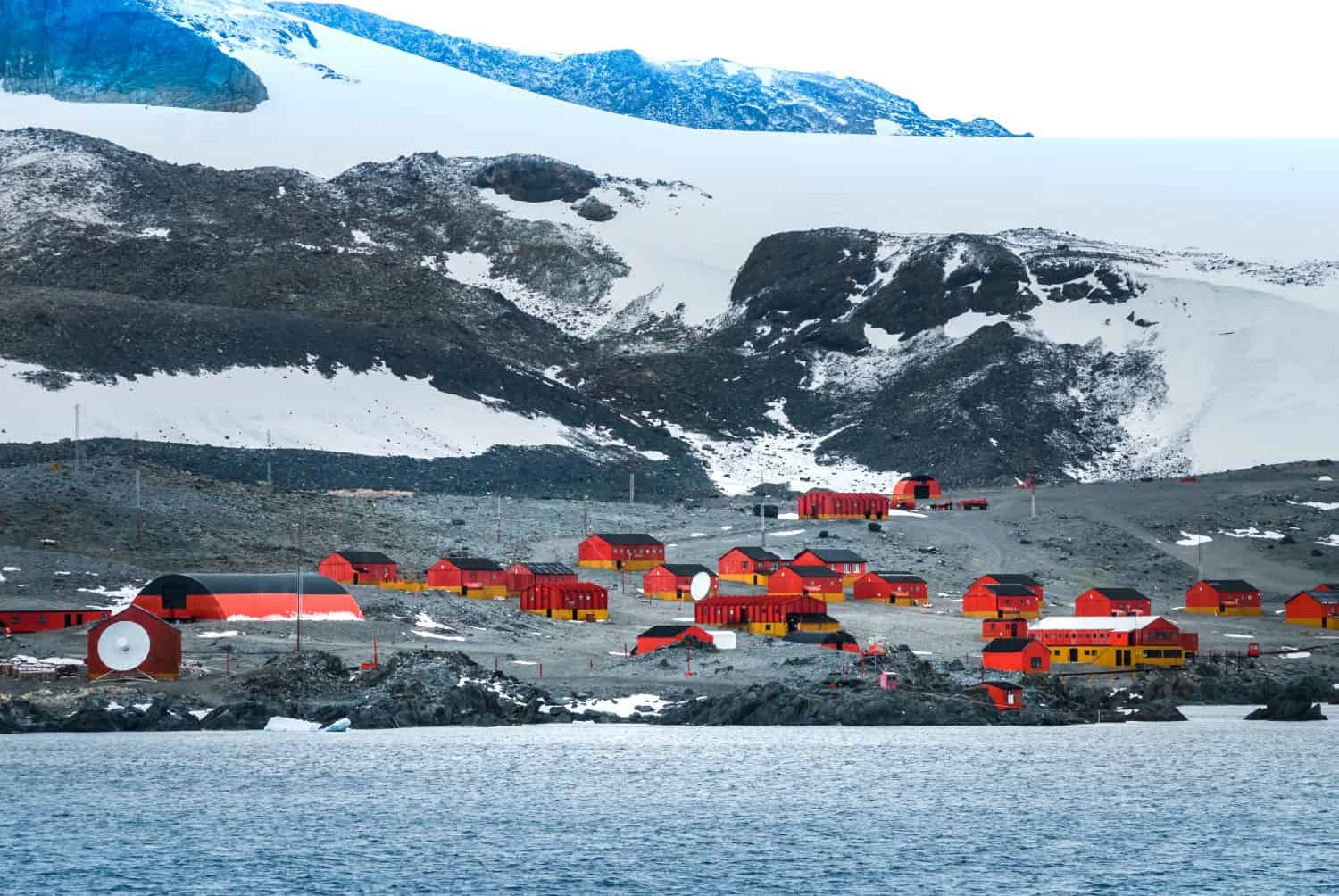
In Antarctica, many scientists live on temporary housing / research bases — like the one pictured above.
©Foto 4440/Shutterstock.com
Though the frigid climate and extreme conditions make it unsuitable for long-term human residence, scientists and researchers from various countries temporarily reside in Antarctica to conduct studies and gather data. Industry experts generally study climate change, astrophysics, meteorology, glaciology, atmospheric conditions, and the Earth’s magnetic field. During this time, they stay at research stations, which provide facilities for the staff to live and work for periods of up to a year at a time. One example is the Amundsen-Scott South Pole Station, operated by the United States. Having said that, let’s explore other impacts humans have on the South Pole.
Human Impacts on the South Pole
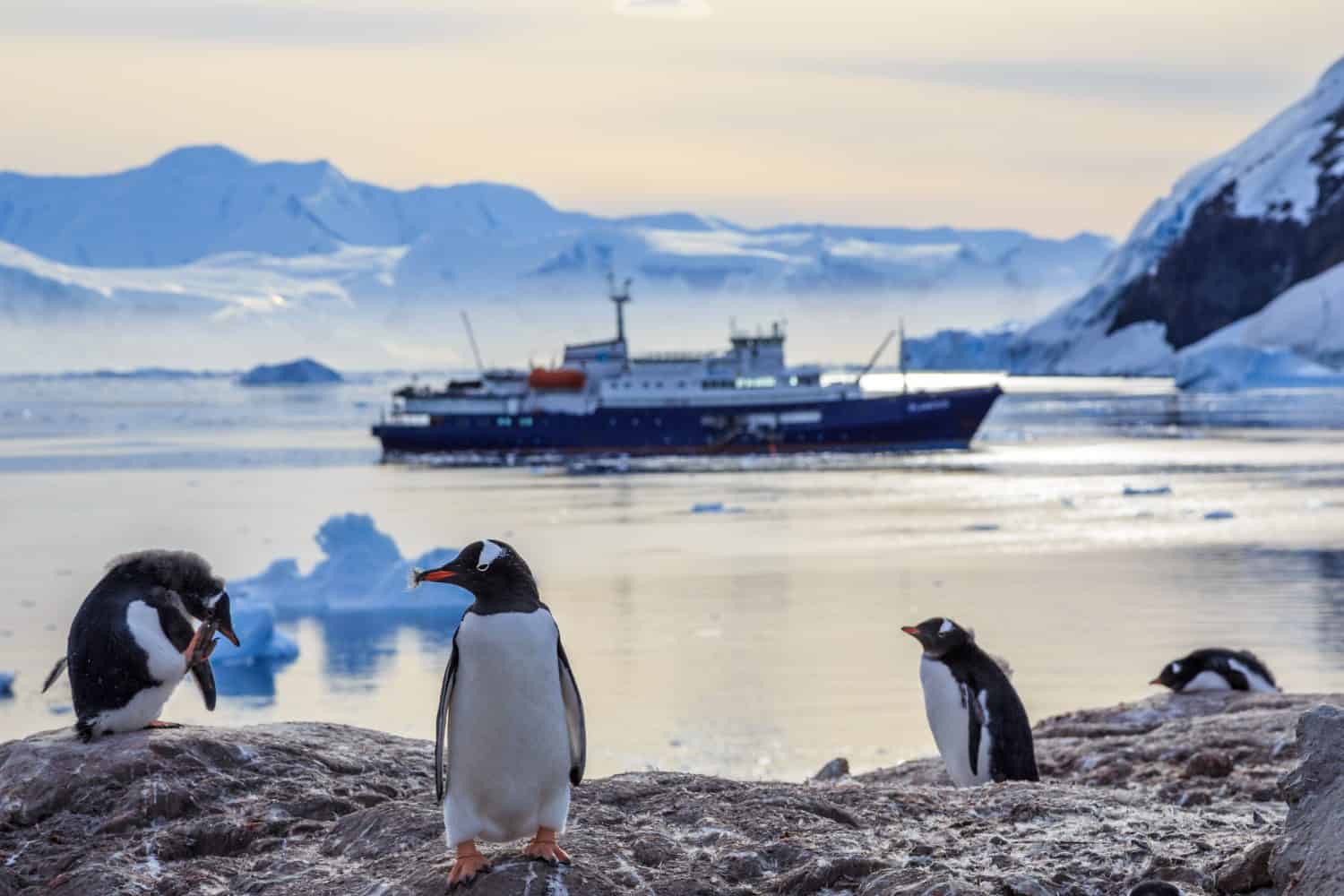
You do not need a visa to visit Antarctica, but you do need a passport to travel through countries you transit through on your way to and from Antarctica, like Argentina and Chile.
©Vadim_N/Shutterstock.com
Tourism in Antarctica goes back many decades. One of the first documented tourist trips was in the 1950s. During this time, Chile and Argentina transported a few hundred fare-paying passengers at a time to see the South Shetland Islands, which are located right off the coast of Antarctica’s mainland. The islands were first sighted in 1819 by William Smith and his crew, who initially named the area “New South Britain.” This area is currently part of the British Antarctic Territory and encompasses about 320 miles of small islands in Antarctica. It is revered for its volcanic, mountainous landscape. Moreover, it was a popular tourist destination due to the high chances of spotting penguins, seabirds, and seals.
First Public Cruise to Antarctica
Lars Eric Lindblad, a Swedish-American explorer, was also a notable figure who greatly impacted the development of tourism in Antarctica. For background, he founded Lindblad Travel in 1958 after immigrating from Sweden. Due to his overwhelming success with his first few launches of public vacation cruises, he had the idea to go even bigger. In January of 1966, he broke records that would change tourism forever. Aboard the Lindblad Explorer, a 104-passenger ship, Lars Lindblad took a group of 57 non-scientists, along with his staff and crew, to the Smith and Melchior Islands. This was the first cruise to Antarctica, as well as the first successful Antarctic cruise with non-scientist passengers. During this tourist venture, passengers traveled from South America to the icy continent of Antarctica. Located in Dallmann Bay, this area featured beautiful landscapes and offered passengers plentiful sightings of whales, seals, penguins, and other Antarctic birds.
These unique expedition-style cruises are still possible thanks to a collaboration between Lindblad Expeditions and National Geographic. The two organizations work together to provide cruise passengers with the most innovative, educational, and sustainable cruise to Antarctica.
In recent years, Antarctic tourism has been booming, with more and more people wanting to see the pristine, untouched beauty of this remote region with their own eyes. Today, there are a handful of modern cruise lines that brave the rocky waters of the Drake Passage to take tourists to Antarctica. Having said that, while tourism can provide economic benefits, it also presents challenges. Managing the number of visitors and their impact on the environment is crucial to ensuring delicate ecosystems are protected. Responsible tourism practices and strict regulations are all quite important to have in place to minimize these negative impacts and protect Antarctica’s ecosystem.
Oil and Mining
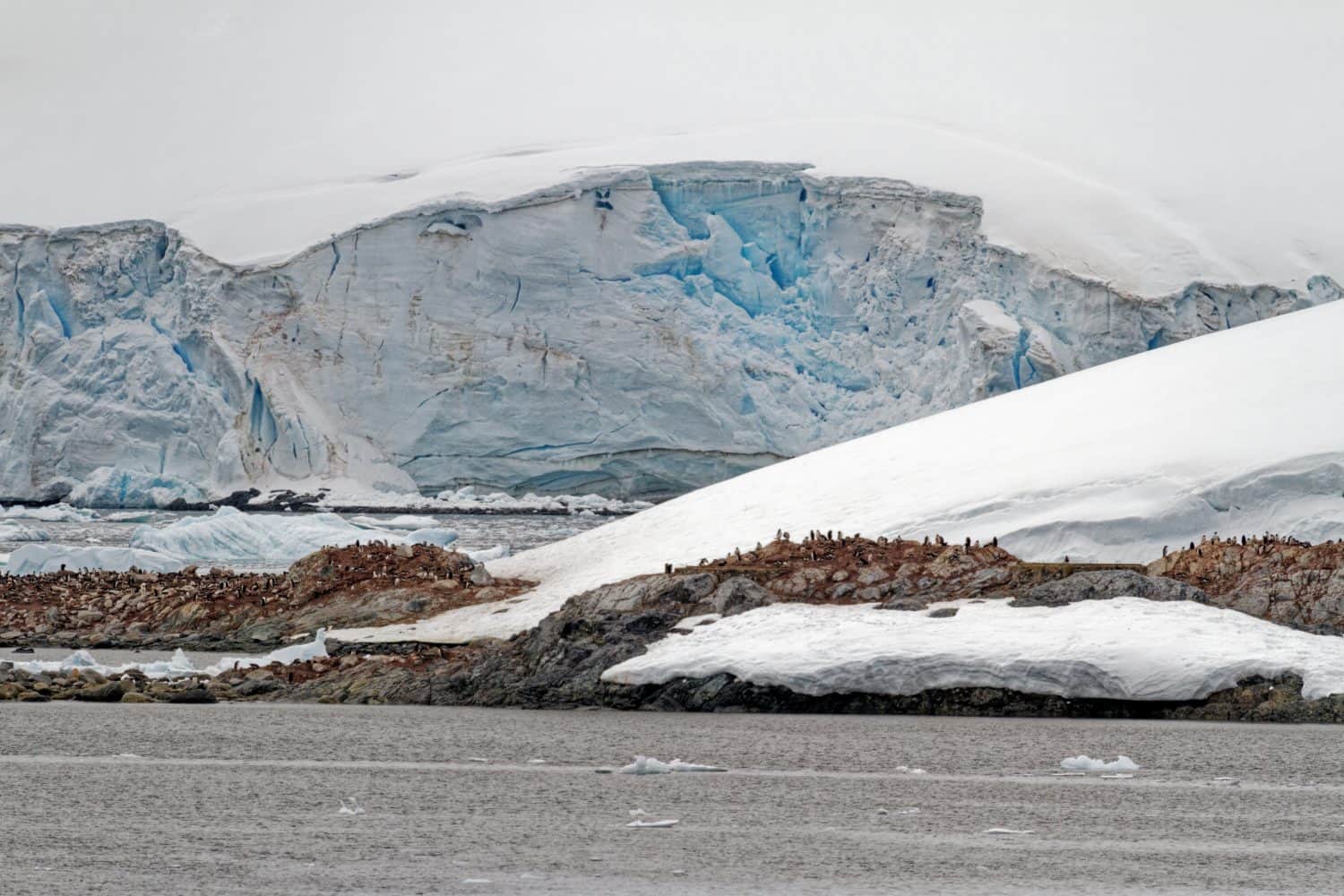
Many environmentalists are against the prospects of drilling or mining in the South Pole, as it will cause great negative impacts on the flora and fauna in the area.
©Ion Mes/Shutterstock.com
There are quite a few potential valuable resources in Antarctica, including manganese nodules and natural gas. Most notably, there is some potential for oil resources beneath the region’s thick ice sheets. This has sparked interest in oil drilling and mining throughout the continent by certain worldwide mega-corporations. Thankfully, the internationally agreed-upon Antarctic Treaty prohibits mining or drilling for these resources. Because of this, there are no current plans to pursue these harmful activities as of today, but we do not know entirely what the future will hold. While such actions would undoubtedly have detrimental effects on Antarctica’s ecosystem and wildlife species, let us hope that this never occurs.
How Can We Preserve the South Pole?
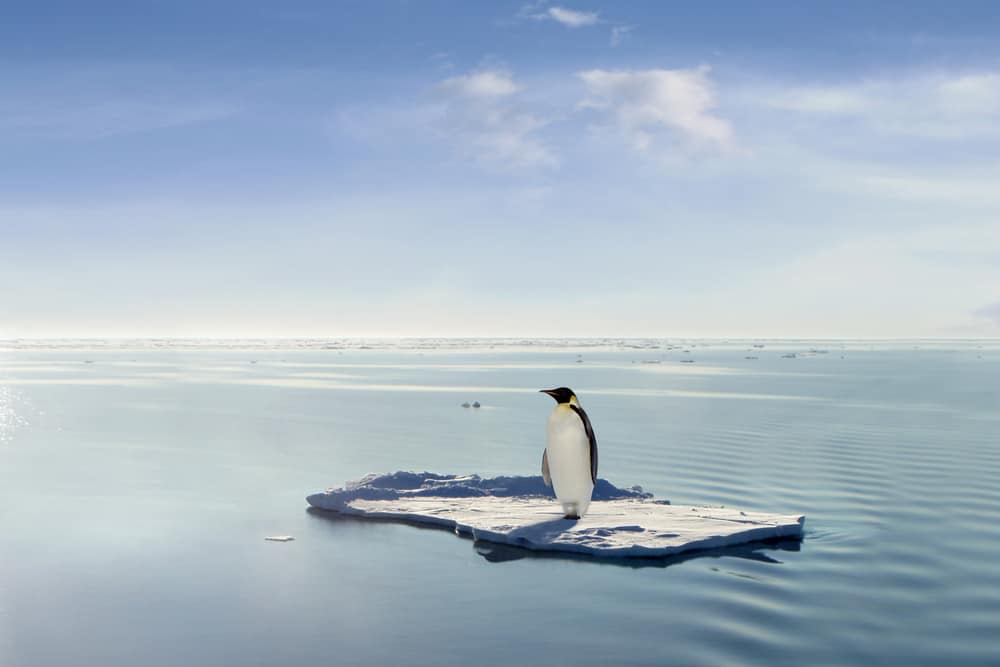
The west coast of the Antarctic Peninsula is one of the most rapidly warming places on the planet, increasing in temperature by 1.8 degrees Fahrenheit in the past decade alone.
©Jan Martin Will/Shutterstock.com
Preserving and protecting the South Pole requires collective efforts from people throughout the world. International collaborations and initiatives, such as the Antarctic Treaty System, play a pivotal role in safeguarding this unique environment from current and future harm. Beyond that, there are many other ways people can help preserve and protect Antarctica to keep its ecosystem clean and its wildlife happy, healthy, and thriving.
Climate Change in Antarctica
Climate change has had a massive impact on Antarctica, and these effects are only getting worse as time goes on. As mentioned previously, the temperatures on the Antarctic Peninsula and in the surrounding Southern Ocean are increasing at an alarming rate. The ice on the continent of Antarctica also isn’t supposed to melt, yet it has been melting more and more each year. Antarctica is melting at an average rate of about 150 billion tons per year, which is three times more than what it was in the 1990s. Furthermore, the rate of ice loss is also increasing six times faster than it was 30 years earlier. These alarming statistics are all caused by the growing effects of climate change.
To preserve and protect Antarctica, we must all work to put a stop to climate change. Reducing global warming is crucial for the well-being of our planet and future generations. Fortunately, there are quite a few ways we can tackle this issue, both on small and large scales. One way we can help minimize climate change is by implementing more sustainable living practices, such as better waste management practices. Additionally, we should work to greatly reduce our carbon footprint.
Ways to Reduce Climate Change on an Individual Level
On an individual level, we can make a significant difference by adopting more sustainable practices in our daily lives. This can be done by living less wastefully. One way people can do this is by conserving energy. This can be accomplished by using energy-efficient appliances like LED light bulbs instead of incandescent ones, turning off lights when not in the room, and unplugging cords when not in use. Fossil fuels, like coal, oil, and gas, are by far the worst contributors to global climate change. This accounts for over 75% of global greenhouse gas emissions and nearly 90% of all carbon dioxide emissions. Knowing that, reducing our reliance on fossil fuels is another way we can reduce climate change and global warming. Carpooling, using public transportation, cycling, or walking when commuting shorter distances are all great ways to start! Additionally, we can minimize unnecessary waste by recycling and/or composting.
Ways Large Companies can Reduce Climate Change
While individuals making more Earth-friendly choices will help reduce climate change, the real impacts are caused by large corporations and companies. According to the Intergovernmental Panel on Climate Change (IPCC), around 70% of carbon dioxide emissions stem from just 100 companies worldwide. As a result, we will need strong international intervention and cooperation to avoid further worsening the effects of climate change. World-wide government bodies must implement strict policies and strong initiatives to help combat global warming and promote a healthier, more sustainable way of life. Another way is through investing in research studies for new clean technologies and processes such as sustainable architecture, reforestation, and green energy.
How Visitors can Help Preserve Antarctica
Another way people can preserve Antarctica is through responsible tourism. For those planning a trip to this icy terrain, it is crucial that they follow the expert’s guidelines to ensure that future generations can continue to experience the same wonders of Antarctica as we do right now. Moreover, tourists visiting Antarctica can do their part to preserve this area by being respectful of the flora and fauna they encounter while there. Any kind of harmful interference with Antarctic wildlife is prohibited. So, being aware of your surroundings and not feeding, touching, or otherwise intervening with the natural wildlife is vital to its overall protection. While these might seem like obvious tips, it goes without saying that you should not litter there or deface the grounds in any other way.
Overall, there are many reasons to put an end to climate change — and just as many ways to help reduce it. By taking direct action to reduce global warming, we can create a more sustainable future where our planet’s flora and fauna can thrive. This responsibility lies on every person’s shoulders because every effort, no matter how large or small, will help minimize climate change. In doing this, we all can contribute to providing a better world for ourselves and for generations to come.
Conclusion
Antarctica, with its extreme climate, breathtaking landscapes, and incredible native wildlife, remains a place of fascination and wonder. This expansive area stands to prove that just about anything can adapt and thrive anywhere in the world — even if the place that they call home is one of the most inhospitable places on Earth! Because of this, it is imperative that we help protect it by preventing climate change.
All in all, by understanding the significance and importance of Antarctica, we can implement best practices to ensure its continued existence in the future. For now, it remains a symbol of yet another one of our planet’s most breathtaking natural wonders.
Thank you for reading! Have some feedback for us? Contact the AZ Animals editorial team.

